The most common questions that we hear at Audubon Society of Western Pennsylvania.
We hope that these resources will help you to not only answer your questions, but to get you thinking about the natural world and our impact on it!
Should I feed birds year-round?
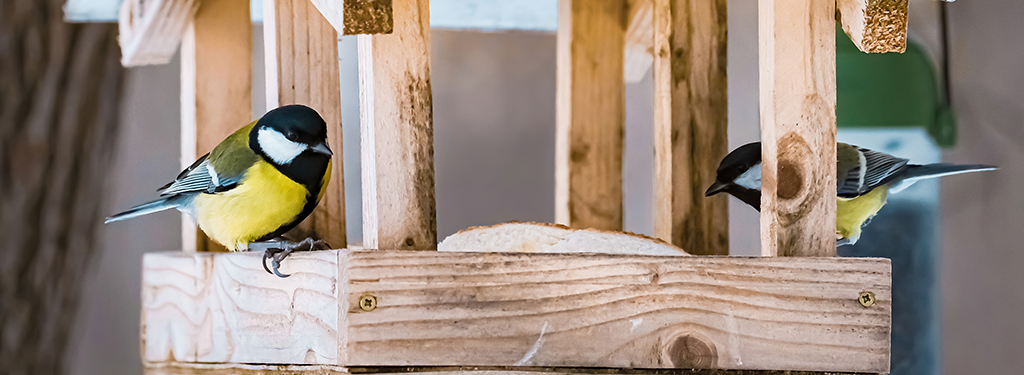
I see the birds eating insects. Should I keep filling the feeder in spring and summer?
For as long as there have been bird feeders, there has been the question as to whether birds should be fed all year or just in winter.
Studies indicate that backyard feeder birds circulate throughout the local environment using all types of food available to them. In fact, the birds that you see at your feeders may only be getting up to 15% of their diet from your feeders, regardless of the season.
While feeding birds can provide them with a convenient option it is important to remember that feeders are not the only food source birds are using.
If you are a winter-only bird feeder(er), here are some things to consider… by extending your feeding season, you can enjoy a much wider variety of birds. In the spring, you might attract migrating birds to your yard. Each year, we hear from excited people who have Rose-breasted Grosbeaks or Indigo Buntings visiting their seed feeders.
By offering food in the summer, you could begin enjoying your local Bluebirds, Baltimore Orioles, or Ruby-throated Hummingbirds. Add in a water source and your yard could attract just about any bird nearby!
You can certainly choose to put a cut-off date on your backyard feeders. But if you enjoy birds and are excited about the opportunity to see them year-round, we invite you to extend your feeding season.
What should I do if I find a baby bird in my yard?
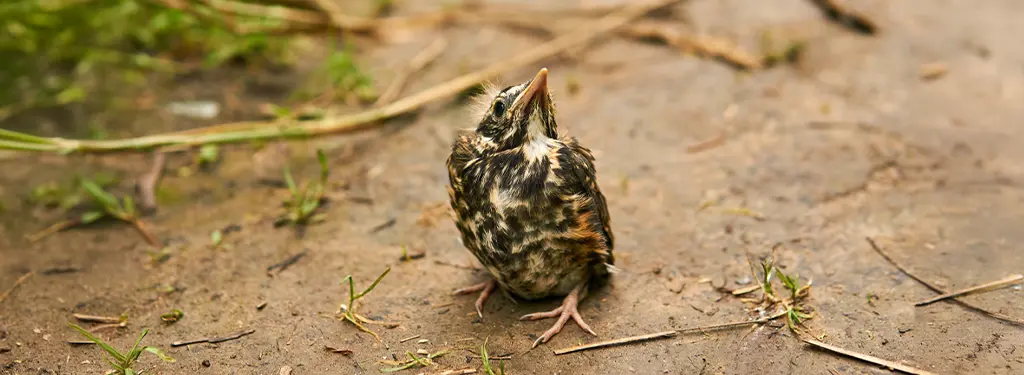
I’ve found a baby bird outside its nest. What should I do?
During springtime and summer, birds in Western Pennsylvania build nests and raise young. While this goes on, you may discover a “baby” bird that is located outside of its nest. ASWP recommends these tips to help the bird remain with its parents:
- Birds grow very quickly and sometimes leave the nest before their feathers fully grow out. When possible, please leave the baby bird alone. That first flight doesn’t always go smoothly—and a bird doesn’t know how to fly until it gives it a try. A bird may flutter to the ground during its first flight. Parents are usually in the area and ready to help them if needed.
- Most birds have multiple chicks and the parents will split their time looking after their brood. If a baby bird looks to be at risk—if it is out in the direct sun or otherwise exposed to predators or danger—move the bird into a nearby bush or shrub. Try to use a bush near where you found the chick so that its parents may easily find it.
- It’s not true that a mother bird will abandon a chick that has been handled by humans. If you need to move a bird into a bush or shrub, the parents will continue to help it.
- Should you find a bird—or any wildlife—with visible injuries, please contact a licensed rehabilitator in your area. There is no need to contact a rehab center for a bird that’s simply fallen out of a nest.
Why are birds attacking my windows?
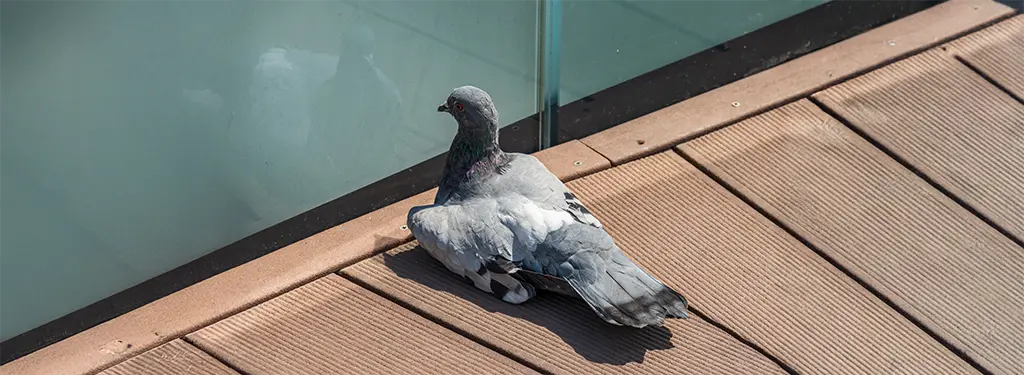
Why are birds attacking my windows?
We all love Spring. The days get longer, the weather gets warmer, the flowers bloom, and birds start attacking windows. It seems like a rite of passage every April through June in Western Pennsylvania. So why do they do this?
The root cause of this behavior is based on territorial defense. When the days get longer, male bird’s hormones rise and the bird begins to select an area to aggressively defend.
Bird territories vary in size depending on the specific species and resources. The American Robin and Northern Cardinal defend relatively small territories, like a small backyard. Other local birds may defend a territory that exceeds 50 acres or more.
Since most birds that sing are males and actively defending a territory, any other male is usually dissuaded from invading that space. If there happens to be any reflective surface around—like your windows—the territorial bird sees its own image and mistakes it for a rival.
This triggers an aggressive response as the bird tries to drive the “interloper” away. The activity may continue throughout the breeding season but passes once the active breeding season ends in June. If it continues, contact our Nature Store for options that look good while keeping birds from impacting windows.
When placing deterrent tape on windows, remember that it’s the window’s outside-facing glass that is reflecting, so placing tape on the inside often doesn’t work. The good news? Anything you do to reduce window aggression in spring will also help to reduce window strikes throughout the year.
How can I attract and support hummingbirds?
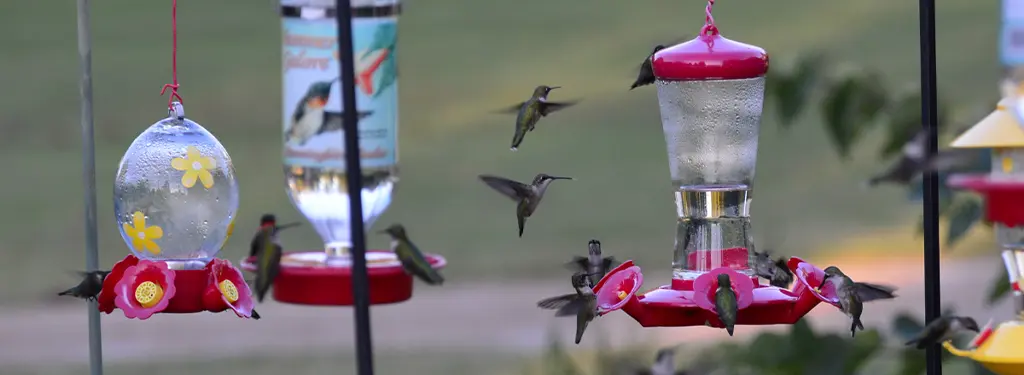
How to attract Ruby-throated Hummingbirds to your Backyard
Did you know that there are more than 330 different hummingbird species (all of them found only in the Western Hemisphere) and the Ruby-throated Hummingbird is the only one found regularly in our area? Each year, these little birds migrate nearly 2,000 miles each way between here and their wintering grounds in Central America—an amazing feat for a bird that weighs only about as much as a penny!
Hummingbirds are fascinating to watch and are quite bold around people. The best way to get them to your yard is by putting out a hummingbird feeder. One of the primary sources of food for hummingbirds is nectar, and sugar water is an easy substitute for your feeder. You can purchase specialty mixes but most people make their own at home using a 4:1 water to white sugar mix (see nectar-making tips below).
Hummingbird feeding basics:
- There are many types of hummingbird feeders, but they fall into two general categories – saucer and bottle. The saucer-type allows for better viewing and is easier to clean. The bottle-type is usually fancier and often holds more liquid. Hummingbirds like them both!
- Place the feeder where it will be easy for you to watch and easy for you to reach. As long as the birds can fly to it, they will find it.
- Try to avoid placing it in a location that gets all-day direct sunlight. That can cause the sugar water to spoil more quickly. If it is in prolonged direct light, change the sugar water every one to two days.
- Clean your feeder at least weekly. A diluted bleach soak (10:1 water to bleach ratio) for 30 minutes works well. Make sure to rinse thoroughly!
- Most saucer type-feeders have a well in their center that you can fill with water. This creates a moat to keep ants and other crawling insects out of the feeder.
- Hummingbirds are highly territorial and—ounce for ounce—some of the most aggressive birds out there. Don’t be surprised if you see only one bird at a time at your feeder or see one chasing other birds away from the feeder. Also, don’t be alarmed if the birds seem to disappear for a while in early summer. There are lots of native plants in bloom at that time and they may be filling up on them. They will return in late summer when many plants quit producing nectar.
- There’s a chance you may see other birds at your hummingbird feeder. Woodpeckers, orioles, and chickadees are all known to stop by for a quick sip, as will moths and butterflies. Raccoons and flying squirrels are also known to stop by for a “nightcap.”
- Sit back and enjoy the show.
Nectar-making tips:
- Use only white cane sugar. Do not use brown sugar or honey – they contain ingredients or compounds that hummingbirds cannot digest.
Mix 1 part sugar with 4 parts water. If putting the entire amount out immediately, stir until the sugar granules dissolve and fill the feeder. If making a larger batch that you will use over a week or more, boil the mixture to make sure it is fully dissolved, then store it in the refrigerator until you use it. - Do not add red food coloring to the mix. Red food coloring may contain ingredients that are harmful to hummingbirds. Although Ruby-throated Hummingbirds are attracted to red colored things, the feeder usually has some red on it.
- Make sure the sugar water has warmed up (if taking it from the fridge) or cooled down (if it was just boiled). The temperature of the sugar water should be the same as the nectar would be from inside a flower.
- Consider making up a simple syrup mixture, a one-to-one ratio of sugar and water. Boil it at a rolling boil for several minutes, then once it is cool, store it in a closed jar in the refrigerator. When you are ready to fill your feeders, add three parts water to one part simple syrup, stir, and serve. One batch of this concentrated mixture should last you several weeks. In addition to saving you time making nectar, you will always have some simple syrup in your fridge if you want to make homemade lemonade or a mojito to enjoy while you watch the hummingbirds at your feeder!
More about hummers
Females are larger than males and have white throats and duller overall coloring, which helps them to stay hidden when sitting on their nests. Those nests are about the size of a quarter and made with lichens, mosses, and other small plant fibers, all “stitched” together with spider web.
The spider web acts like elastic, allowing the nest to expand as the chicks get larger. The female lays 1-3 eggs (each smaller than a pea) and does all of the incubation and parenting by herself. The total time from when the egg is first laid until the young bird leaves the nest is about five weeks.
Why are woodpeckers pecking at my house?
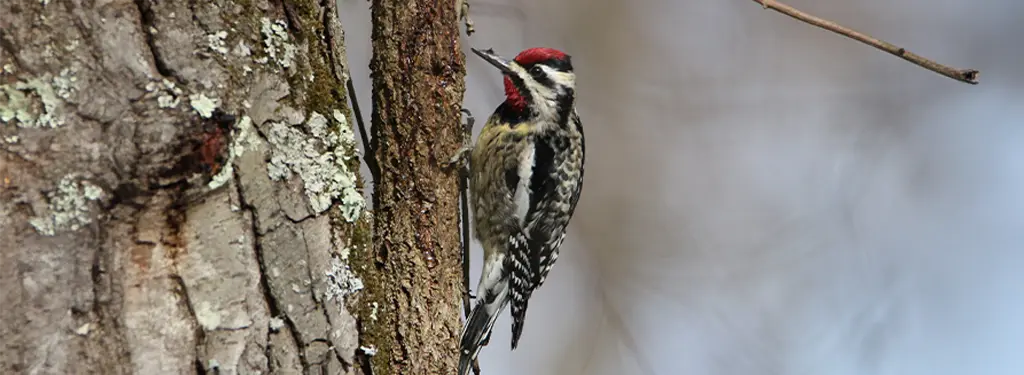
Why is a woodpecker pecking at my house?
Woodpeckers claim and defend a territory. If you’re hearing them hammering on the side of your house (and other wooden structures), it’s likely during the spring when they’re protecting their realm.
“Drumming,” when male woodpeckers repeatedly peck on a hard wood or sometimes metal surface, is a way that the birds broadcast their territory. It works for them—and for other birds—but may not be so appealing to the humans who hear the ruckus.
If you hear drumming from a woodpecker, know that it will subside when the breeding season winds down. There’s no proven or reliable method to deter woodpeckers—and sprays and chemicals don’t work (and they can negatively impact other beneficial species). But be sure to check out the situation if the drumming continues. It can be a sign that you have insects or other food sources underneath the siding of your house.
What’s the best way to reduce Spotted Lanternflies?

Spotted Lanternfly – Squish, Don’t Stick
Spotted Lanternfly numbers are up in our region, and we’ve heard numerous reports of well-meaning homeowners covering trees with sticky tape to capture the invasive lanternflies.
Audubon Society of Western Pennsylvania encourages the public NOT to use sticky tape for Spotted Lanternfly control. The tape lives up to its name and can capture birds and beneficial insects, leading to serious injury or a prolonged and painful death. Birds trapped in the tape fight to escape, losing feathers, breaking bones, and leaving themselves vulnerable to predators.
Be a friend to birds and beneficial insects – say ‘no’ to sticky tape and ‘yes’ to the tried-and-true method of squishing Spotted Lanternflies.






